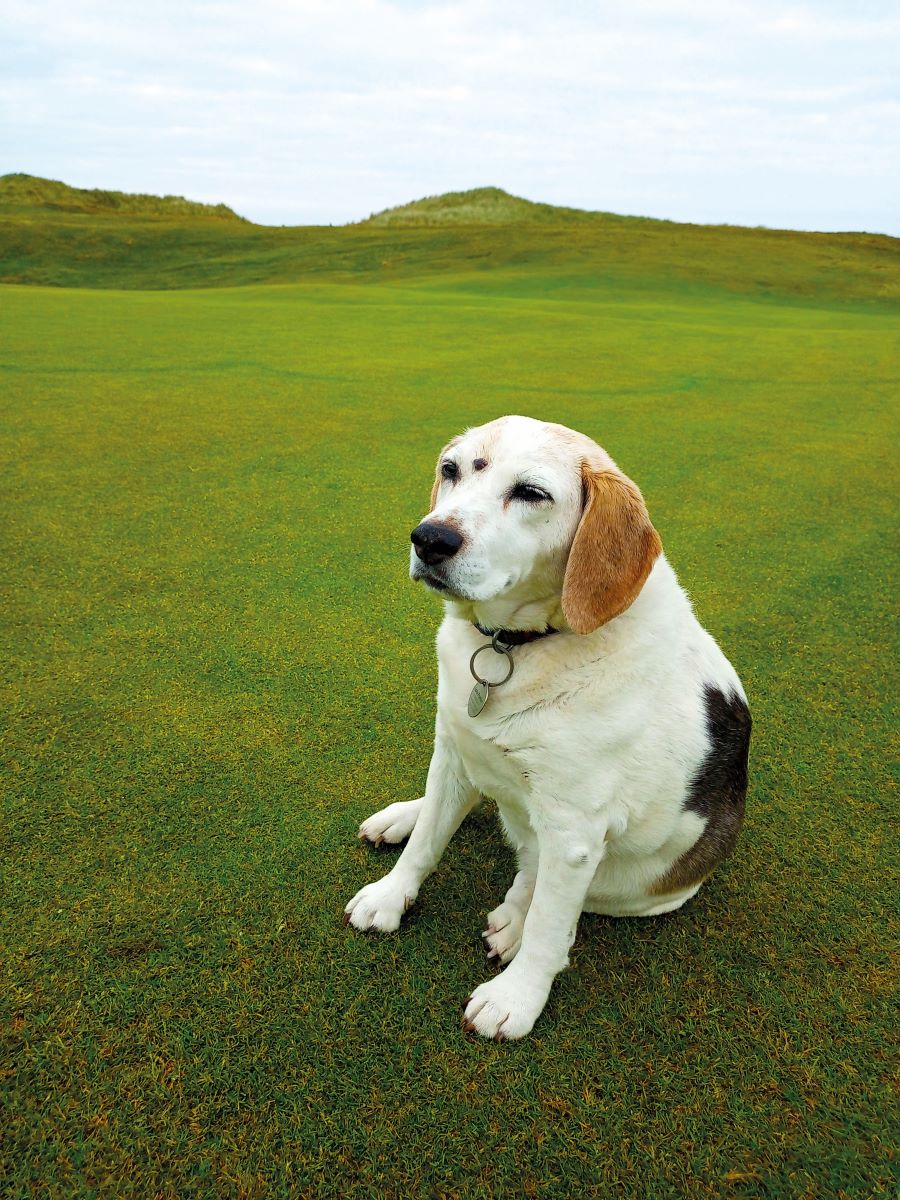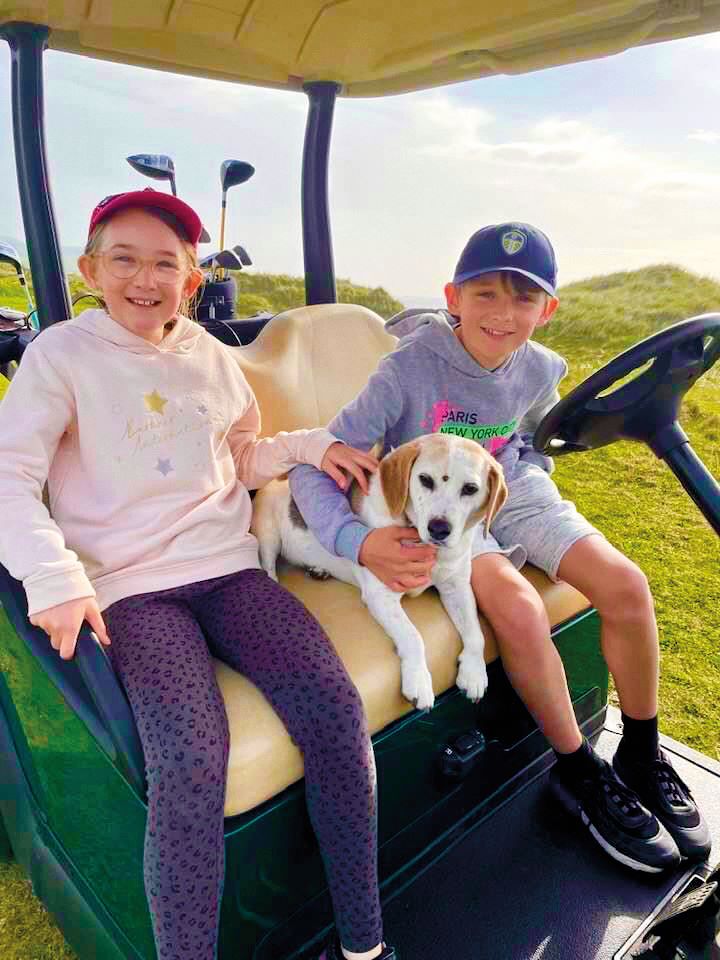- Homepage
- News and Features
- A reflection on dogs, golf, greenkeeping – and life itself
A reflection on dogs, golf, greenkeeping – and life itself
James Parker, the course manager at Machrihanish Dunes on Scotland’s Kintyre Peninsula, celebrates the life of his Beagle, Lola, who offered loyal companionship and so much more during her master’s golfing travels.

Earlier this year we said goodbye to our loyal dog after almost 15 years together. Lola, a beautifully natured Beagle, was a wedding gift to my wife, Sarah, a companion for us both and the very first member of our blossoming family.
Having decided as a family to devote ourselves to the management of sports turf, Lola travelled with us on our numerous adventures throughout the UK.
Lola was undoubtedly a dog destined for the golf course. From bounding around Gleneagles in the snow as a pup, to walking the links of St Andrews on our pilgrimage to the Auld Grey Toun, Lola was a turf dog.
Having lived near Troon for a while, we found great happiness sitting as a family watching the sun set from the tee box of the Postage Stamp.
The loss of Lola raised some interesting realisations, not least giving me an opportunity to write this article which serves as a fitting memory to a golf course dog. However, more importantly it could provide some interesting lessons about the challenges faced by turf managers up and down the land.
Dogs and golf have a long history together. Since the formation of the game, it is clear that dogs have often shared the links with their human companions. Many early paintings of the game depict players sharing their golfing recreation with their canine friends. One of the most famous of these – a picture depicting Freddie Tait with his terrier Nails – hangs in the clubhouse of The R&A.
More recently, dogs have gained a prominent place in the world of turf management. Likely originating from our agricultural counterparts, the working dog has become an increasingly common sight on sports facilities throughout the world. Rising rapidly in popularity, turf dogs have been featured in articles, videos, blogs and social media with one popular social media account registering more than 11,000 followers.
Despite their popularity, the subject of dogs and their place on golf courses remains a polarising subject. It is not my intent to change any opinions on a dog’s place within turf management, but simply to give all an understanding of what canine companionship achieved for me.

On Friday, February 24, Lola spent her last day with me on the golf course. The next morning I returned to work alone for the first time in many years.
Despite being only a 10-minute commute, that journey felt like the longest I had made in a career spanning 17 years.
Although Lola could offer no academic input to my morning routine, her presence alone for many years had been enough to keep me calm, focused and relaxed, choosing to adopt a dog’s mentality of playing and living in the moment.
While bereavement is experienced by all of us throughout our lives, the feeling of loneliness, despair and fear can never be truly understood until such an event occurs. Loss can raise questions within us and force us to face some of our greatest personal challenges.
Man’s best friend
The reason people migrate towards dogs is that fundamentally dogs are people orientated. Studies throughout the years have shown good evidence to this effect. Often referred to as man’s best friend, domesticated dogs have simply learned that, to survive, human interaction is vital.
Staring into the eyes of a dog is reported to have similar effects on the adult mind to that of staring into the eyes of an infant. The bonding stare of a dog increases hormonal Oxytocin levels creating a feeling of affection. Good owners value the qualities of their dog. They appreciate that, in return for this nurture and care, a dog will give them joy, companionship and years of devotion. This symbiotic relationship has been proven to significant effect for centuries. The dog’s desire to interact with humans has personally given me the greatest pleasure.

Over the years I have shared in the enjoyment gained by greens staff who had adopted Lola as our Team Dog. Her presence around the facility has allowed staff members to come out of their shells, to form closer relationships with me and to enjoy the company of a dog even if their own personal circumstances prevented them from owning one themselves.
Lola provided many laughs and at numerous venues become an integral part of the team serving as a welcome morale boost on some of the bleakest days. Her get-up-and-go attitude meant that even in the very worst of the British weather, a course walk was never neglected.
Conversation starters
Dogs are social creatures. Owning a turf dog had for many years been a bridge between me and the golfing public. After decades in the industry, it may be fair to say that we all have reached points and occasionally been unwittingly conditioned to believe that all golfers are the same and that most members are out to get us. It becomes easy as humans to judge everybody by our own opinion and, where possible, to hide away from those who we deem to be getting in our way or causing trouble.
Dogs, though, are different.
Lola, like all animals, was completely non-judgemental. To her, a human was a human and everyone that walked on two legs was fair game. To a dog, all humans are both friendly and carrying food.
It was often with trepidation that I would see her bounding off towards the captain’s tan chinos or hanging round that stuffy group who were usually best avoided.
Those seemingly stressful moments served a purpose, a purpose I only began to appreciate some years down the line.
The wandering actions of a carefree dog forced me to engage, to be a face and not just a body, to be a mouth and not someone rendered speechless.
Such interactions with members led to us to forming great friendships, gaining allies with people we had prejudged to be enemies.
Even the most hardened of opponents would crack a smile or make a gesture of goodwill with the dog in tow.
Reduced loneliness
Despite industry friends, good supervisors and regular participation with fellow turf professionals, turf management remains a lonely enterprise. Managing a golf course on a day-to-day basis, while rewarding, can undoubtedly result in feelings of isolation and separation, particularly when the going is tough.
Because of their obvious inability to converse verbally with humans, dogs serve as great listeners. For a number of years I often found myself walking the course with the dog discussing disease, heights of cut, nutrition, HR, fertility, fixture lists and budgets – the list was endless. Now, while Lola was no accountant, agronomist or plant pathologist, that downloading of information and the constant upbeat wag of the tail was often enough to ease my concerns or for me to gain clarity in my own thoughts. Those moments always served as a reminder that solace can be found in meeting the simple necessities of life – in family, in friends, in colleagues and leisure.
Calmness and relaxation
The distraction a dog offers is a huge aspect that I will miss about Lola. Every course manager at times can feel overwhelmed when problems arise. Some weeks it just seems as if nothing will go your way. You head out on the course bouncing and return to the office scratching your head. In those moments, socialisation with a canine friend can have some very positive effects. According to research, dogs are great at offering sensory stress relief. Stroking or hugging a dog during times of stress has an almost instant impact helping you to calm down and relax. Playing with your dog, perhaps in the office over a break, can increase Serotonin and Dopamine levels, giving feelings of calmness and control.
Those moments of distraction help a course manager to stay in the moment and cease catastrophising over situations beyond our control. They remind us that all challenges, however upsetting, remain temporary.

Lola had an old tennis ball that instantly changed her mood – I believe we all need an equivalent in our lives.
Just as an old tennis ball or stuffed toy can change a dog’s mood instantly, finding a mental trigger to persevere and carry on can keep us driving forward even when a temporary situation feels overwhelming.
I do appreciate that dogs are not everyone’s cup of tea. Some people have circumstances that restrict them from owning an animal. Some will work at golf clubs that do not embrace dogs. Others will simply not feel compelled to own a pet. That is all fine.
This piece, while therapeutic to write, is not about increasing canine ownership. It is simply a wake-up call that all of us managing turf need to develop coping strategies.
Turf management is not getting easier. Over the past decade, many articles have been written about the increasing pressures of managing sports turf. If we are to be realistic, those pressures are not going away. Increasing restrictions, tightened finance and difficult recruitment aligned with ever-increasing expectations, are problems that are here to stay. Developing coping mechanisms and nurturing the ones we already have are vital in safeguarding our mental wellbeing. A mind well looked after that can cope with moderate levels of stress is far more productive, creative and intuitive.
Each of us can develop our own coping strategies. Where possible, developing multiple ones is highly advantageous. Over the past five years many fine individuals have left this wonderful profession. Could it be though that some would still be here had they had their own coping mechanisms in place?
In the meantime, I head home every day leaving one member out on the course. Despite having a wonderful companion and a great coping strategy for the last 15 years, I now find myself having to come up with a new one. While we will undoubtedly return a turf dog to the Mach Dunes family at some stage, for now we mourn the loss of Lola. And I have begun addressing some of my challenges, those that she did so well to help me find a way through.
Author

